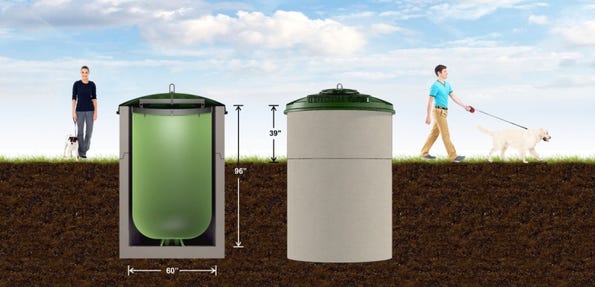South Carolina Company Putting a New Spin on the Bin
A South Carolina firm is pushing a new concept in waste bins—one that stores waste partially underground in order to keep trash cooler, reduce odors and use less space than traditional bins.
Sutera USA, based in Greenville, S.C., has created the semi-underground waste containers that store waste vertically in a concrete well five feet below the surface and 39 inches above. A reusable bag made of 18-oz. PVC-coated polyester fabric is suspended within the well.
According to Bill Higgins, director of business development for Sutera USA., the semi-underground system has several benefits, including lower underground temperatures that slow bacterial development and odors, less property space required for the container and increased capacity.
“The Sutera lid is water tight. Rain water does not enter and leach through the waste. Any leachates created by the waste are contained in our monolithic concrete well, pumped out as required and disposed of in an environmentally responsible manner,” Higgins says.
But with the benefits come some significant challenges.
“Any change—even for the better—is always a challenge. This change will be driven at first by the user not the service provider,” says Higgins. “The service industry wants the concept proven and the density of our product built before they will invest in converting or buying the truck required to service semi-underground containers.”
Semi-underground containers were invented in Europe 20 years ago and have been in use in Ontario, Canada, for the past 15 years. In parts of Ontario, any new building, commercial, residential, municipal, or educational, is designed with semi-underground container. Traditional waste containers are discouraged, Higgins says.
“Sutera has improved the concept. We replaced the plastic well with a readily available precast concrete well, a manhole available anywhere roads are built, and introduced it to the U.S. this year,” he says.
The first container in the U.S. was installed at Sutera’s parent company, Melloul Blamey Construction in Greenville, S.C., two years ago.
“It was our prototype. In those two years no leachate or rainwater accumulated in the well,” Higgins says. “We are slowly and methodically blazing a trail in South Carolina. Once that trail is open there will be much traffic.”
Sutera USA started marketing the semi-underground container earlier this year.
“Until we were in a position to service the container we were not selling; only promoting the concept,” says Higgins.
Currently, Sutera has one conventional 25-cubic-yard compacting truck and is adding a second smaller multi-use one to service parks.
“We are introducing the semi underground concept as a system concentrically from Greenville, S.C. Once we have shown the concept works there and we have built density other service providers will add or convert trucks to service semi-underground to compete. This was the experience in Ontario, Canada,” Higgins says.
To collect the waste, the bag is lifted out of the well by a hook-lift garbage truck. Once in the correct position, the bag opens from the bottom, emptying its contents into the back of the truck. The bag is then repositioned over the well, the cinching mechanism reset, and the bag is lowered back into the well. The entire process requires approximately three minutes to complete.

About the Author
You May Also Like


